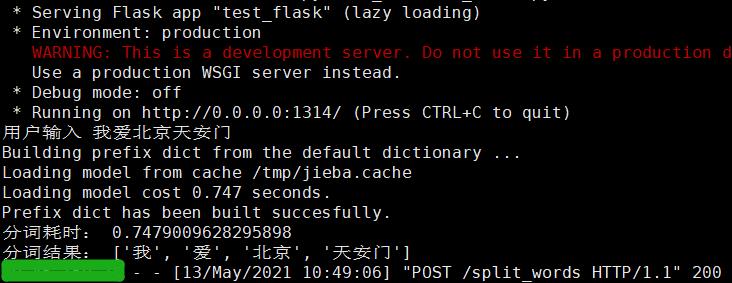如何使用flask将模型部署为服务
Posted 西西嘛呦
tags:
篇首语:本文由小常识网(cha138.com)小编为大家整理,主要介绍了如何使用flask将模型部署为服务相关的知识,希望对你有一定的参考价值。
在某些场景下,我们需要将机器学习或者深度学习模型部署为服务给其它地方调用,本文接下来就讲解使用python的flask部署服务的基本过程。
1. 加载保存好的模型
为了方便起见,这里我们就使用简单的分词模型,相关代码如下:model.py
import jieba
class JiebaModel:
def load_model(self):
self.jieba_model = jieba.lcut
def generate_result(self, text):
return self.jieba_model(text, cut_all=False)
说明:在load_model方法中加载保存好的模型,无论是sklearn、tensorflow还是pytorch的都可以在里面完成。在generate_result方法中定义处理输入后得到输出的逻辑,并返回结果。
2. 使用flask起服务
代码如下:test_flask.py
# -*-coding:utf-8-*-
from flask import Flask, request, Response, abort
from flask_cors import CORS
# from ast import literal_eval
import time
import sys
import json
import traceback
from model import JiebaModel
app = Flask(__name__)
CORS(app) # 允许所有路由上所有域使用CORS
@app.route("/", methods=[\'POST\', \'GET\'])
def inedx():
return \'分词程序正在运行中\'
@app.route("/split_words", methods=[\'POST\', \'GET\'])
def get_result():
if request.method == \'POST\':
text = request.data.decode("utf-8")
else:
text = request.args[\'text\']
try:
start = time.time()
print("用户输入",text)
res = jiebaModel.generate_result(text)
end = time.time()
print(\'分词耗时:\', end-start)
print(\'分词结果:\', res)
result = {\'code\':\'200\',\'msg\':\'响应成功\',\'data\':res}
except Exception as e:
print(e)
result_error = {\'errcode\': -1}
result = json.dumps(result_error, indent=4, ensure_ascii=False)
# 这里用于捕获更详细的异常信息
exc_type, exc_value, exc_traceback = sys.exc_info()
lines = traceback.format_exception(exc_type, exc_value, exc_traceback)
# 提前退出请求
abort(Response("Failed!\\n" + \'\\n\\r\\n\'.join(\'\' + line for line in lines)))
return Response(str(result), mimetype=\'application/json\')
if __name__ == "__main__":
jiebaModel = JiebaModel()
jiebaModel.load_model()
app.run(host=\'0.0.0.0\', port=1314, threaded=False)
说明:我们定义了一个get_result()函数,对应的请求是ip:port/split_words。 首先我们根据请求是get请求还是post请求获取数据,然后使用模型根据输入数据得到输出结果,并返回响应给请求。如果遇到异常,则进行相应的处理后并返回。在__main__中,我们引入了model.py的JiebaModel类,然后加载了模型,并在get_result()中调用。
3. 发送请求并得到结果
代码如下:test_request.py
import requests
def get_split_word_result(text):
res = requests.post(\'http://{}:{}/split_words\'.format(\'本机ip\', 1314), data=str(text).encode(\'utf-8\'))
print(res.text)
get_split_word_result("我爱北京天安门")
说明:通过requests发送post请求,请求数据编码成utf-8的格式,最后得到响应,并利用.text得到结果。
4. 效果呈现
(1)运行test_flask.py

(2)运行test_request.py

并在起服务的位置看到:

至此,我们的整个流程就完成了。
以上是关于如何使用flask将模型部署为服务的主要内容,如果未能解决你的问题,请参考以下文章
独家 | 手把手教你如何使用Flask轻松部署机器学习模型(附代码&链接)